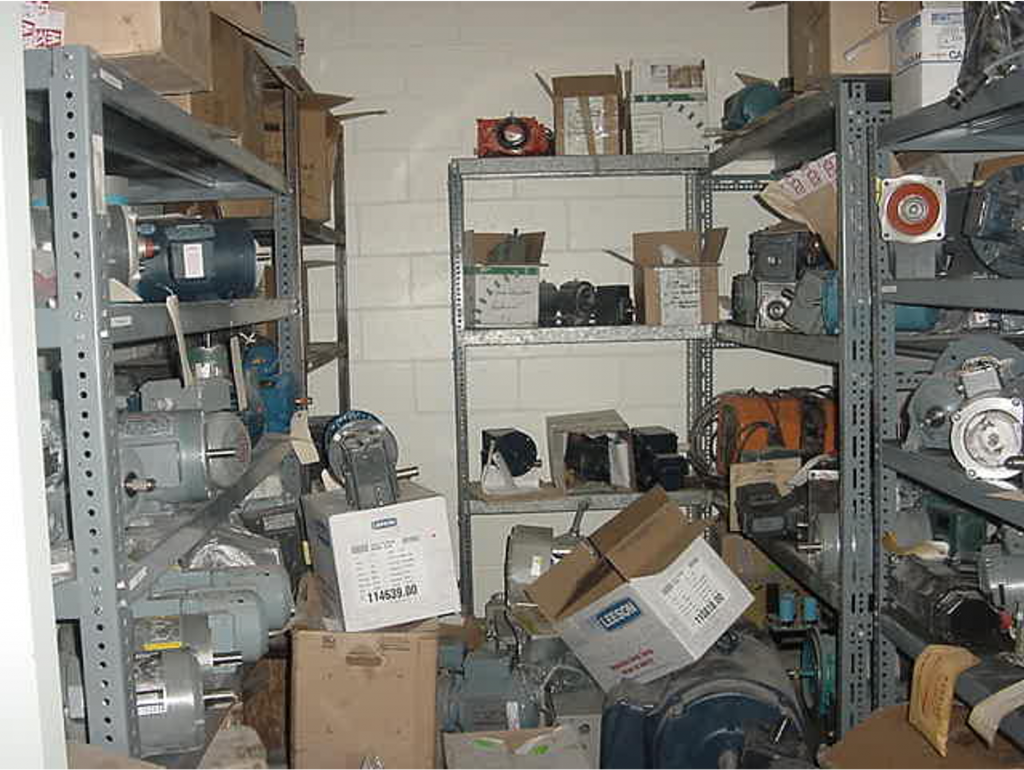A full review has been conducted on one of SQF certified food processing/packaging plant, specifically the maintenance department. This site is in the process of achieving level 1 of TPM.
Reviewed site has some of the structure in place to eventually sustain the 7 elements of the fundamental phase required for Planned Maintenance. However the elements need to be reinforced and shifted into high gear in order for the site to be able to engage in more sustainable Proactive work and begin the process of reducing Reactivity.
Below you will find list of top recommendations at this time, the recommendations, if implemented, will add a higher and more sustainable level of effectiveness to maintenance and increase asset availability for production.
Parts and Materials
“Best stockrooms observed are manned whenever maintenance works”

- Blitz the stockroom and complete within a 3 to 6-month period.
- Review Action Plan in PM manual before you select space requirements.
- Remove from inventory all obsolete items, including very low-usage items (i.e. items not used in more than two years, etc.).
- Eliminate duplication of inventories in the plant.
- Upfront the installation of the new CMMS for the stockroom first so that as part’s attributes are obtained, they can be entered in the system once!
- Create your unique Part No.
- Review and establish item description (use both supplier’s and internal definitions), average price, primary supplier, bin location, and safe delivery time.
- Reduce the number of parts locations to “one.”
- Using the “parts classification” document on the PM manual, code the parts in CMMS based on how critical they are to your process (must have in-house, 24-hrs away, 3-days away, etc.), and verify a time with vendors.
- Based on asset criticality, classify the parts accordingly, establish proper reorder level, and reorder quantity for all items in inventory based on delivery time. Start low at first. Place info in CMMS, also.
Do not “go live” with CMMS until information loading is complete. Set a schedule!
- Obtain approval on the total $ required to satisfy EFFECTIVE reorder levels established above and modify levels as needed.
- Install a workstation (with CMMS) outside the storeroom for the users to query information on parts and eventually issue parts themselves if the stockroom remains open.
- Establish stockroom written procedures, including disciplines to maintain low stock-outs, design and set new ways of working.
- Train the users on how to issue and remove parts from inventory in CMMS. 5s the stockroom.
- Perform full inventory and correct quantity on hand in CMMS.
- Soon after inventory, initiate new stockroom ways of workings and sustaining. Now go-live!
- Adjust levels, monitor usage and establish performance indicators.

CMMS
- Strongly recommend acquiring web-based (cloud-based) CMMS software, carefully examining old data, and suggesting not to bring present historical data into new CMMS. Become part of the CMMS corporate user group. Set good disciplines of usage up-front and maintain.
- Install additional workstations for CMMS to expand work request program entry to all.
Asset Criticality
Classify all major assets by how critical they are to the business. Prioritize maintenance accordingly. Do this first to help prioritize your parts, PMs, and resources available to the most critical assets.
Planning and Scheduling
- Strongly consider separating the Planner’s duties from the Supervisor’s duties. At least one full-time planner is needed. If you have to, reduce your present trades to create a dedicated planner.
- Increase Planning and Scheduling work, and make CMMS the primary source for asset/equipment history and analysis.
- Increase analysis of Major Breakdowns over 1 hour, record in CMMS eventually, and if necessary, contact CMMS support to add Breakdown Analysis module.
Work orders
- Number and label all your equipment.
- Soon after the stockroom is up and running, initiate a full work order program for all work done by maintenance via CMMS, and link the work orders to the equipment where the work is done.
- Link the part’s cost and labour cost to the asset via a work order.
- Establish discipline of no parts issued without a work order.
- Train trades to enter work directly into CMMS and monitor the information with the planner.
- Begin using performance indicators and analyzing your cost.
Preventive Maintenance
- Based on the asset criticality established, modify, and reformulate current PMs if needed to include parts needed, special tools necessary, safety tips, and specific instructions.
- Separate PMs from PMIs and precede the PMIs as much as possible, design and fit PMs to the individual performing the task.
- Take full advantage of windows of opportunities during the week by having work ready to go, and parts staged and reserved.
- Formalize a “doable” lubrication program, examine suppliers of lubricants, execute the program via work orders and support Autonomous Maintenance.
- Maintain and perform at least one PM procedure and inspection for every critical equipment in the plant.
- Do not release any PMs that you are not sure of their value to the equipment.
Always ask – if this PM is not released on time, does the equipment run the same without failure?
Basic Maintenance Management
- Begin monthly meetings within the maintenance department to promote communication and increase awareness of PROACTIVITY. Demonstrate commitment to moving away from reactive maintenance; let everyone know!
- Create and display PM Activity Boards, maintain and update.
- Prioritize stockroom reorganization completion, and promote usage of CMMS for maintenance documentation and analysis.
- 5S the shop area.
- Begin measuring/establishing KPIs.
- Consider “shift overlaps” between shifts for mechanics until CMMS is up and running for them.
- Monitor/Verify preventive maintenance is getting done.
- Implement daily maintenance log. If CMMS doesn’t have this feature, look for another provider or customize CMMS to have this option.


















